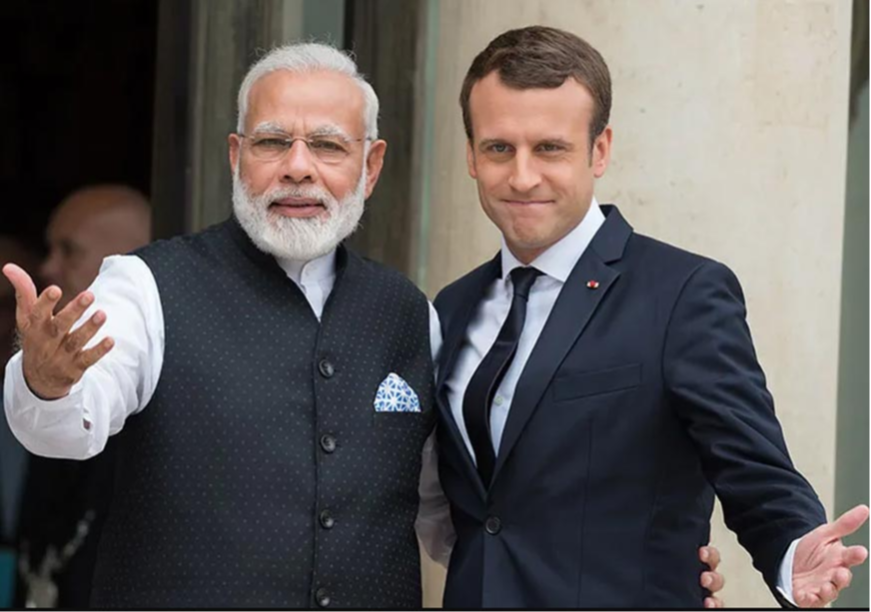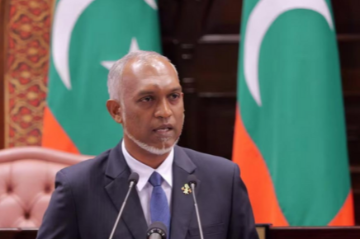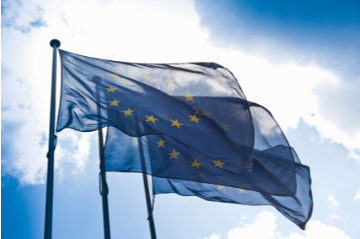
In New Delhi, President Macron's state visit marked a historic moment as France and India signed a joint commitment to combatting climate change and advancing clean energy. Their collaboration signifies a shift towards tangible actions in fostering sustainability, spanning from solar energy initiatives to nuclear power advancements.
The visit resulted in several agreements and announcements, including, in the fields of International Solar Alliance (ISA), green hydrogen, and nuclear energy, which are crucial for the global energy transition and the fight against climate change.
The India-France collaboration within the ISA enhances bilateral relations and boosts global solar energy promotion, showcasing the potency of international alliances for sustainable development.
The G20 New Delhi Leaders Declaration and COP28 presidency endorse tripling global renewable energy capacity and doubling energy efficiency rates by 2030, aligning with net-zero targets.
In a world increasingly turning to renewable energy sources, the ISA emerges as a pivotal force in shaping the global solar landscape. With ambitious targets of mobilising US$1 trillion in solar investments by 2030, the ISA stands at the forefront of a burgeoning industry. The projected leap from US$310 billion in 2022 to US$380 billion in 2023 underscores the momentum driving solar investment.
The G20 New Delhi Leaders Declaration and COP28 presidency endorse tripling global renewable energy capacity and doubling energy efficiency rates by 2030, aligning with net-zero targets. The ISA supports member nations in accelerating solar energy adoption to achieve this goal, requiring collaborative efforts from governments, industries, and communities. To meet net-zero targets, global solar PV capacity must increase to 600GW/year from 2023 to 2030, and further to 1000GW/year from 2030 to 2050. Notably, the solar PV installed capacities of India and France as of December 2023 have been 70.09 GW and 2.3 GW respectively.
Moreover, initiatives focusing on solar PV panels, battery and waste management, and solar hydrogen underscore the ISA’s relentless pursuit of solar technology innovation. Yet, transcending mere innovation, solar energy carries the profound potential to uplift communities worldwide. In this regard, solar power emerges not only as a sustainable solution but as a catalyst for social and economic empowerment, aligning closely with the ISA's overarching mission.
The collaborative efforts of India and France culminated in the unveiling of a visionary plan during COP27—the ISA's SolarX Grand Challenge. The first SolarX Grand Challenge is focusing on Africa, aiming to find new ideas and solutions in solar energy. Over 100 startups from Africa's solar industry will participate, wherein around 20 of the best startups will get help with both money and technical support.
The first SolarX Grand Challenge is focusing on Africa, aiming to find new ideas and solutions in solar energy.
Moreover, both nations have embarked on joint endeavours aimed at mobilising resources for solar projects in developing regions, with a particular focus on Africa. Notably, the announcement of a solar academy in Senegal under the STAR-C program exemplifies their enduring partnership within the ISA framework. This initiative, borne from the shared vision of India and France, epitomises their steadfast commitment to equipping nations with the necessary knowledge and skills to harness solar energy effectively, thus driving sustainable development on a global scale.
France and India also stand poised to collaborate in green hydrogen, propelling their clean energy transitions to reach carbon neutrality targets. Green hydrogen, derived from renewable sources like solar and wind via water electrolysis, offers a pathway to decarbonise challenging sectors such as transport, industry, and power generation.
In a landmark move on 18 October 2022, France and India embraced the “Indo-French Roadmap on the Development of Green Hydrogen,” aiming to converge their hydrogen ecosystems for a sustainable value chain. Through this roadmap, both nations commit to regulatory framework development, carbon-content certification, scientific research collaboration, and fostering industrial partnerships.
As far as India’s Green Hydrogen Mission is concerned, its comprehensive budget stands at INR 19,744 crores, envisaging investment of over INR 8 lakh crore and the creation of over 6 lakh jobs by 2030. Furthermore, India is ambitiously aiming to reach a green hydrogen production capacity of 5 million metric tons annually by 2030, a move set to revolutionise its energy landscape. This initiative is poised to curtail 50 million metric tons of CO2 emissions and save a staggering INR 1 trillion on fuel imports. With India expected to expend US$373.4 billion or (₹31.07 trillion)*, on energy imports in FY 2024, this strategic shift holds immense promise for both economic and environmental sustainability. Furthermore, The Union Budget for 2024-25 has earmarked a significant sum of INR 600 crore for this mission, reflecting a remarkable surge of 102 percent from the preceding fiscal year's allocation of INR 297 crore.
France and India embraced the “Indo-French Roadmap on the Development of Green Hydrogen,” aiming to converge their hydrogen ecosystems for a sustainable value chain.
On the other hand, France's visionary national strategy aims to propel the hydrogen sector, positioning the nation as a premier force in Europe. Under Plan France 2030, the target is to produce 700,000 tons of renewable or low-carbon hydrogen annually by 2030, with a corresponding electrolyser capacity goal of 6.5 GW. Additionally, the strategy sets an ambitious price target of US$1.6 per kg for hydrogen by 2030.
France's ambitious strategy boasts a 7.2 billion euros or (INR 641 billion) public investment plan slated for realization by 2030, with 2 billion euros or (INR 178 billion) earmarked for execution by 2022 and 3.4 billion euros or (INR 302.6 billion) by 2023. Anchored by a trio of pivotal objectives, the strategy seeks to cultivate a robust French electrolysis industry, drive the decarbonisation of heavy industry and transportation sectors, and foster research and development alongside skill enhancement for hydrogen's forthcoming applications. France also aims to curtail its industrial carbon dioxide emissions by 34 percent, marking a significant stride towards sustainable industrial practices.
Thus, India and France, recognising their complementary strengths in green hydrogen, have forged a strategic alliance. India, with its abundant solar and wind resources and burgeoning energy demand, complements France's advanced technology and expertise in hydrogen production, storage, and distribution, coupled with a firm commitment to climate action. Through collaborative efforts and shared expertise, they aim to lead the global transition towards decarbonised hydrogen, while fostering trade, energy security, and international cooperation.
Besides, India and France are forging a robust partnership in the realm of nuclear energy, recognising its pivotal role as a low-carbon and reliable power source. While India's nuclear energy sector presently contributes less than 2 percent to annual electricity generation, its growth potential is significant. In contrast, France emerges as a global leader in civilian nuclear energy, heavily relying on nuclear reactors to produce 65 percent to 70 percent of its electricity, the highest proportion globally. This stark contrast in their current nuclear energy profiles highlights the diverse trajectories and potential collaboration avenues between the two countries in advancing nuclear energy technology and utilisation.
India, with its abundant solar and wind resources and burgeoning energy demand, complements France's advanced technology and expertise in hydrogen production, storage, and distribution, coupled with a firm commitment to climate action.
Their collaborative efforts extend to the research and development of small modular reactors, (SMRs). SMRs offer versatile, scalable solutions for diverse energy needs, ranging from 1Mwe to over 300 MWe. They replace fossil fuel-fired plants and diesel generators, preserving jobs and reducing emissions, while complementing renewables to ensure grid stability. SMRs also provide heat for various applications, supporting net-zero targets, particularly hard-to-abate industrial sectors, through their integration with renewables.
In parallel, significant strides have been made in advancing the Jaitapur nuclear power plant project, poised to become the world's largest with six EPR reactors each boasting a capacity of 1650 MW and net generation capacity of 9900 MW, a testament to the technical cooperation between the two nations. EPR or the European Pressurized Reactor is a third-generation pressurized water reactor, known for its advanced safety features, such as double containment building, core catcher, and passive safety systems.
Furthermore, India and France have committed to establishing a specialised task force dedicated to advancing nuclear energy initiatives, which would oversee various aspects of nuclear cooperation. It would focus on partnership establishment in small and advanced modular reactors, and enhance exchanges in reactor safety, research, waste management, and non-electrical applications. Additionally, it would monitor the Jaitapur Nuclear Power Project's progress, thereby contributing to climate change mitigation efforts by promoting clean energy sources.
EPR or the European Pressurized Reactor is a third-generation pressurized water reactor, known for its advanced safety features, such as double containment building, core catcher, and passive safety systems.
The alliance between France and India emerges as a beacon of hope in the fight against climate change and the pursuit of sustainability. Their joint efforts within the ISA, advancements in nuclear energy, and strides in green hydrogen showcase a shared dedication to innovation and environmental progress. As they lead the way towards a cleaner future, France and India demonstrate the transformative potential of collaboration, paving the way for a sustainable legacy and a brighter tomorrow.
Manish Vaid is a Junior Fellow at the Observer Research Foundation.
The views expressed above belong to the author(s). ORF research and analyses now available on Telegram! Click here to access our curated content — blogs, longforms and interviews.




 PREV
PREV


